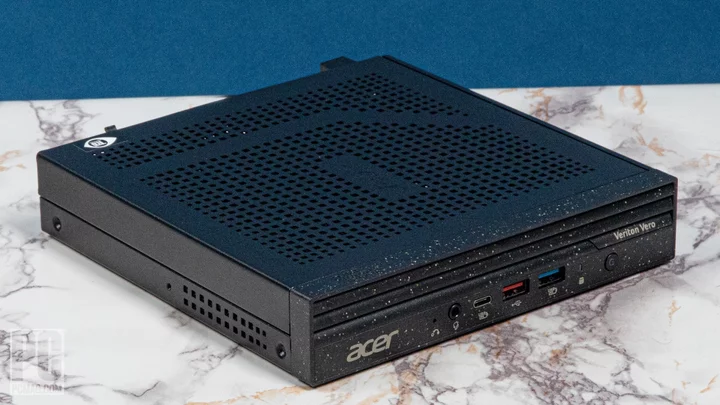While mini PCs are becoming increasingly popular, the Acer Veriton Vero Mini (starts at $849.99; $1,119.99 as tested) doesn’t technically qualify as one—rather, we'd classify it as a small-form-factor desktop. This computer is worth considering if you need more power than a "true" mini PC but are still highly space-constrained. (It comes complete with a VESA mount to take it entirely off your desk, if you want to fix it behind a monitor.) While many compact PCs require you to add the memory, a boot drive, and the operating system, the Veriton Vero Mini is a ready-to-use PC. Our review unit even includes a decent keyboard and mouse, as well as Windows 11 Pro. Unpack it, plug it in, and you’re ready to go. That said, the price for our test model suggests you should wait for a sale before considering this machine, as it doesn't deliver quite the level of performance the price should command.
Design and Configuration: Upgrades Aren’t Easy
Measuring only 1.4 by 7.3 by 7.3 inches (HWD) and weighing 2.87 pounds, the Vero Mini is not much larger than many Intel NUC clones. The Vero Mini is available with your choice of several Intel CPUs with embedded graphics, the norm for mini PCs. Our review unit was equipped with an Intel Core i7-12700T, a low-power-consumption desktop CPU clocked at a relatively poky 1.4GHz. (A full-power Core i7 desktop chip would be hard-pressed not to thermally throttle in such a slim chassis.) The desktop's communications capabilities are up-to-date, with Wi-Fi 6, Gigabit Ethernet, and Bluetooth 5.3.
(Credit: Molly Flores)Most NUC-style and other small-form-factor PCs don’t contain a lot of upgrade options. Of course, you won't find any PCI Express slots to add a graphics card, and most are limited to one or two SO-DIMM slots. This upgrade limitation is true of the Vero Mini, though the review unit I received has one open RAM slot. (The other slot contained a 16GB SO-DIMM.) That allows you to bump up the memory to 64GB by replacing the 16GB SO-DIMM with a 32GB one and adding a second 32GB SO-DIMM in the other slot.
As tested, my review unit also has a bracket for a 2.5-inch SSD or mechanical hard drive to supplement the 1TB M.2 SSD that the Vero came equipped with. (The motherboard has only a single M.2 slot, which was occupied by the boot drive.) The Veriton's 12th Gen Core i7-12700T CPU, base-clocked at just 1.4GHz, puts a damper on performance, but its 12 cores help it manage more processing threads at once. The upside of this CPU choice is that it allows for a small CPU fan that's quiet and kept the PC cool through several hours of testing.
(Credit: Molly Flores)These somewhat limited upgrades are available if you can figure how to open up the case—initially, I couldn’t. The limited documentation provides no clues on how to do this, nor does the online service manual, which showed a completely different case style with an expansion case attached. I finally found a YouTube video that showed how to open the case and access the 2.5-inch bracket, as well as remove the fan assembly to get at the second DIMM slot.
Using the Veriton Vero Mini: Here a Port, There a Port
On the plus side, this Vero Mini configuration has a lot of ports, especially for a PC of this size. In addition to an HDMI port, a DisplayPort connection, a Gigabit Ethernet port, and an audio jack, the Acer also has seven USB connections. These include two USB 2.0, three USB 3.2 Gen 1 Type-A, one USB 3.2 Gen 2 Type-A, and one USB-C.
(Credit: Molly Flores)Two of the USB-A ports, as well as the single USB-C connection, are on the front panel along with the headset jack and power button. The rear panel is populated by four USB-A ports, HDMI and DisplayPort outputs, the RJ-45 Ethernet jack, and the power jack. The Veriton Vero Mini may be small, but the large, 135-watt external power supply is about the same size as those that come with many laptops. The cables are long enough that you can probably hide the chunky power-supply block on the cord behind your desk, so I don’t view the somewhat large brick as a problem. The HDMI and DisplayPort allow you to work with two monitors at once.
(Credit: Molly Flores)Having seven available USB ports is a big plus, though only one of these connections being USB-C (much less without Thunderbolt 4) is limiting, as these days a large number of USB devices and accessories are of the USB-C variety.
Testing the Veriton Vero Mini: Veritably Middle-of-the-Road
We subjected the Veriton Vero Mini to our standard benchmark suite for desktops. In our tests, we compared the Veriton Vero Mini with several other recommended mini PCs: the Asus ExpertCenter PN52, the Geekom iT8 Mini, the Intel NUC 12 Pro Mini, and the MSI Pro DP21. All of these—except for the Asus PN52, which has an AMD Ryzen 7 processor—have Intel CPUs ranging from Core i3 to Core i7 levels of performance. But there are crucial differences among them.
For one, the H-series chip in the Asus PN52 is the kind of CPU that is intended for gaming laptops and other power-user notebooks. Two of the systems in the comparison (Geekom and the Intel NUC 12) employ lighter-weight mobile chips. The Veriton Vero Mini itself uses a low-power desktop T-series processor, and the MSI has a standard desktop Core i3.
Productivity Tests
We run the same general productivity benchmarks across both mobile and desktop systems. Our first test is UL's PCMark 10, which simulates a variety of Windows apps to give an overall performance score for office-centric tasks such as word processing, spreadsheeting, web browsing, and videoconferencing, all commonly performed tasks on a PC such as this one. PCMark 10 also includes a storage subtest for the primary drive, which measures the program load time and throughput of the boot drive (a solid-state drive, and the only drive in the test configuration).
Three other benchmarks focus on the CPU, using all available cores and threads, to rate a PC's suitability for processor-intensive workloads. Maxon's Cinebench R23 uses that company's Cinema 4D engine to render a complex scene, while Geekbench 5.4 Pro from Primate Labs simulates popular apps ranging from PDF rendering and speech recognition to machine learning. Finally, we use the open-source video transcoder HandBrake 1.4 to convert a 12-minute video clip from 4K to 1080p resolution (lower times are better).
Last, we run PugetBench for Photoshop by workstation maker Puget Systems, which uses the Creative Cloud version 22 of Adobe's famous image editor to rate a PC's performance for content creation and multimedia applications. It's an automated extension that executes a variety of general and GPU-accelerated Photoshop tasks ranging from opening, rotating, resizing, and saving an image to applying masks, gradient fills, and filters.
Starting with the two PCMark 10 tests, these scores position the Veriton Vero Mini toward the middle or top of the group, with the Asus PN52 and Intel NUC 12 Pro Mini winning out in the main test and only the NUC 12 beating the Acer on the storage trial. In the HandBrake test, where lower times are better, the Vero Mini dropped to the second-to-last position, where only the Geekom IT8 was a bit slower. That CPU-centric test was a bit of a disappointment, considering the next two.
As for CPU-bound 3D rendering speed, the Acer’s multi-core score in Cinebench sent it to the top of the group, likely by dint of its 12 total on-die cores. This performance carried through to the Geekbench 5.4 multi-core CPU test, where the Vero Mini landed in second place after the NUC 12 Pro Mini. We were unable to get the Photoshop benchmark to run on the Vero Mini, so we have no score for that.
Looking at these results, the Acer Veriton Vero Mini is a mixed bag, sometimes delivering on CPU-intensive tasks and perfectly capable on office-oriented tasks such as word processing, spreadsheets, and browsing. It didn't dominate throughout, though, a big surprise considering its lower-power desktop chip up against, mostly, mobile ones.
Graphics Tests
We test the graphics inside all laptops and desktops with two DirectX 12 gaming simulations from UL's 3DMark: Night Raid (more modest, suitable for laptops with integrated graphics) and Time Spy (more demanding, suitable for gaming rigs with discrete GPUs).
To further measure GPUs, we also run two tests from the cross-platform GPU benchmark GFXBench 5, which stresses both low-level routines like texturing and high-level, game-like image rendering. The 1440p Aztec Ruins (which this PC was unable to run) and 1080p Car Chase tests, rendered offscreen to accommodate different display resolutions, exercise graphics and compute shaders using the OpenGL programming interface and hardware tessellation respectively. The more frames per second (fps), the better.
We had much better luck running the 3DMark benchmark tests. In 3DMark Time Spy, the Vero Mini fell right in the middle of the pack, with the Intel NUC and the Asus ExpertCenter scoring noticeably better. Our Night Raid benchmark results then saw the Vero Mini take a second-place win; it was much more in its element in that test.
As for GFXBench, the Acer couldn't run the Aztec Ruins test, serving up repeated crashes. The Vero Mini did somewhat better on the Car Chase test, though: While it was considerably slower than the Intel NUC, Acer's mini rig was speedier than the Asus PN52. Regardless, you're not coming to a small PC like this for raw pushing of polygons—just productivity. This is typical performance for integrated Intel graphics.
Verdict: For the Cash, Needs More Power
Depending on how you intend to use it, the Acer Veriton Vero Mini may be exactly what you need, but its price in our test configuration is difficult to justify considering what it served up in our tests. While it's decent at performing office-oriented tasks, has a lot of ports, and has a VESA mount, we have trouble recommending this PC unless it's discounted a fair amount. The single USB-C port, without Thunderbolt 4, is especially tough to tolerate at this price. Instead, we still recommend the Asus ExpertCenter PN52 and, perhaps, remaining units of the Intel NUC 12 Pro as a better values.









